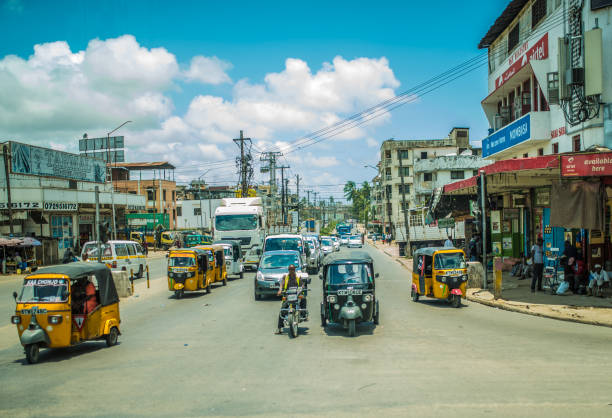1} NAIROBI
Nairobi, the capital city of Kenya, stands out as the most developed county in the country due to a combination of historical, economic, and infrastructural factors.
With a rich colonial past and strategic geographical location, Nairobi has become a hub for commerce, finance, and innovation, driving its overall development.
One key factor contributing to Nairobi’s development is its historical significance. The city was established in the late 19th century as a railway depot during British colonial rule. Over the years, it evolved into a major administrative and economic center.
The legacy of colonial-era investments and infrastructure laid the groundwork for Nairobi’s subsequent growth, giving it a head start over other counties.
Economically, Nairobi plays a pivotal role in Kenya’s financial landscape. It hosts the Nairobi Securities Exchange, the country’s primary stock exchange, attracting domestic and international investors.
The concentration of financial institutions, including banks and investment firms, further enhances Nairobi’s economic prominence. The city’s status as the economic heartbeat of Kenya translates into increased opportunities for employment, entrepreneurship, and economic prosperity.
The presence of international organizations and embassies in Nairobi is another testament to its global importance. As the diplomatic and political capital of Kenya, Nairobi hosts numerous foreign missions and international agencies, fostering diplomatic relations and collaborations.
This global engagement contributes to the city’s cosmopolitan atmosphere and facilitates international trade and cooperation.
Nairobi’s infrastructure development is a key driver of its status as the most developed county. The city boasts modern transportation networks, including an international airport, a well-developed road system, and a commuter rail network. These infrastructure investments facilitate the movement of goods and people, supporting economic activities and enhancing the overall quality of life for residents.
Moreover, Nairobi serves as a technology and innovation hub, with a growing number of tech startups and innovation centers.
The city’s commitment to fostering a conducive environment for technological advancements has attracted both local and international tech talent. Initiatives such as the Konza Technopolis project aim to position Nairobi as a leading technological hub in Africa, further propelling its development.

While Nairobi’s development is evident, it’s important to acknowledge the existing socio-economic disparities within the county. Disparities in access to basic services, such as education, healthcare, and housing, remain challenges that need addressing. Efforts to ensure inclusive development will be crucial for Nairobi to truly serve as a model for the entire country.
2} KIAMBU
Kiambu as the “most developed” county in Kenya is subjective and could be influenced by various factors. Kiambu, being a part of the Nairobi Metropolitan Region, has experienced significant economic growth and infrastructural development.
One of the key reasons for its perceived development is its proximity to Nairobi, the capital city. This has attracted both residential and commercial investments, contributing to infrastructural advancements such as good road networks and accessibility.
Kiambu is known for its agricultural productivity, with a substantial portion of its land dedicated to farming. The county’s favorable climate and soil conditions make it suitable for various crops, further boosting its economic stability.
The county has witnessed the establishment of educational institutions, healthcare facilities, and other public services. Urbanization has led to the growth of towns within Kiambu, promoting trade and commerce.
However, it’s important to note that development is multifaceted and can be measured in different ways. While Kiambu may excel in certain aspects, other counties in Kenya might showcase strengths in different areas. Factors such as employment opportunities, social services, and poverty levels also play a crucial role in determining overall development.
Kiambu has certainly seen notable progress and development, declaring it the most developed county requires a comprehensive and objective analysis of various indicators to provide a well-rounded assessment of its standing compared to other counties in Kenya.
3} MOMBASA
Mombasa as the “most developed” county in Kenya is also subjective and context-dependent. Mombasa, as Kenya’s second-largest city and a major coastal hub, has experienced notable development across various sectors.
One significant factor contributing to Mombasa’s perceived development is its strategic location as a major international port. The Port of Mombasa serves as a key gateway for trade, facilitating economic activities and contributing to the county’s economic growth.
The port’s presence has attracted business investments, fostering commerce and infrastructure development in the region.
Mombasa is a prominent tourist destination, drawing visitors with its historical sites, cultural diversity, and beautiful coastal landscapes. The tourism sector plays a crucial role in the county’s economy, leading to investments in hospitality, entertainment, and related infrastructure.
The county has also witnessed improvements in transportation infrastructure, with well-maintained roads and the Moi International Airport serving as essential components for both local and international connectivity.
However, it’s essential to consider that development encompasses various dimensions, including social services, education, healthcare, and overall quality of life. While Mombasa may excel in certain aspects, the overall development of a county is a complex and multifaceted evaluation.
Mombasa’s development is influenced by its economic activities, tourism potential, and strategic location. However, determining it as the most developed county requires a comprehensive analysis, considering various indicators and comparing it with other regions in Kenya to provide a balanced assessment of its developmental status.
4} NAKURU
Nakuru County, situated in the Great Rift Valley of Kenya, has emerged as one of the most developed regions in the country due to various factors. Its strategic location, nestled between Nairobi and Western Kenya, has contributed to its economic significance. Nakuru is a key transportation hub, intersected by major highways and hosting a busy railway station, facilitating the efficient movement of goods and people.
The county’s economic prosperity is largely attributed to its vibrant agricultural sector. Nakuru’s fertile soils support the cultivation of diverse crops, and the county is a major player in horticulture and floriculture. The agricultural activities are complemented by Lake Nakuru, a Ramsar Wetland site and a haven for flamingos, attracting tourists and fostering the growth of the hospitality industry.
Nakuru has also become a focal point for industrial development. The Nakuru Industrial Park, established to promote manufacturing and processing activities, has attracted investments, creating job opportunities and boosting the local economy.
The county’s industrialization drive has been supported by a skilled workforce and the availability of raw materials from the agricultural sector.
In terms of infrastructure, Nakuru boasts well-maintained roads, enhancing connectivity both within the county and with neighboring regions. The county government’s commitment to improving urban infrastructure has led to the development of modern housing, commercial complexes, and recreational facilities in Nakuru town.
Moreover, Nakuru has prioritized education and healthcare, evident through the establishment of quality schools and healthcare facilities. This focus on human development contributes to a skilled and healthy population, essential for sustained growth.
Nakuru County’s development is a result of its strategic location, thriving agriculture, burgeoning industries, robust infrastructure, and investments in education and healthcare. The synergy of these factors has positioned Nakuru as a model for development in Kenya, showcasing the potential for balanced and inclusive growth in other regions of the country.
5} KAJIADO
Kajiado County, located in the southern part of Kenya, has emerged as one of the most developed regions in the country, marked by significant progress in various sectors. The county’s economic growth can be attributed to its strategic location, natural resources, and a proactive approach to development.
Firstly, Kajiado benefits from its proximity to Nairobi, Kenya’s capital, fostering economic ties and providing access to key infrastructure and services.
This geographical advantage has attracted investments and business activities, contributing to the county’s economic prosperity.
The county’s economy is diverse, with agriculture playing a crucial role. Kajiado boasts fertile land suitable for both livestock and crop farming. Livestock farming, including cattle ranching, is a significant contributor to the county’s economy, supporting local livelihoods and enhancing food security.
Furthermore, Kajiado has witnessed substantial infrastructural development. Improved road networks facilitate transportation and connectivity, promoting trade and ease of access to markets. Investments in education and healthcare infrastructure underscore the county’s commitment to human capital development.
The tourism sector in Kajiado has also flourished, driven by its rich cultural heritage and the presence of iconic landmarks such as the Maasai Mara National Reserve. Tourism contributes to the local economy through revenue generation and job creation, fostering sustainable development.
Kajiado County’s leadership has played a pivotal role in fostering development. Effective governance and proactive policies have created an enabling environment for businesses to thrive, attracting both local and international investors.
This has resulted in job opportunities, improved living standards, and overall socio-economic progress.
Kajiado County’s development can be attributed to its strategic location, economic diversification, infrastructure investment, and effective governance.
As the county continues to evolve, it serves as a model for balanced and sustainable development, contributing significantly to Kenya’s overall progress.

